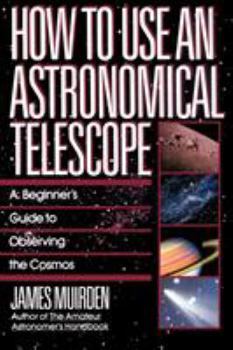How to Use an Astronomical Telescope: A Beginner's Guide to Observing the Cosmos
Select Format
Select Condition 
Book Overview
Astronomy has never been a more popular pastime than it is today. The increased availability of less expensive, more powerful, and more sophisticated telescopes has given rise to a new generation of stargazers. And for these beginning astronomers here is the comprehensive book covering everything from the difficult task of selecting an instrument to the equally daunting choices that arise when a telescope is turned to the heavens.
Renowned British...
Format:Paperback
Language:English
ISBN:0671664042
ISBN13:9780671664046
Release Date:June 1988
Publisher:Touchstone Books
Length:400 Pages
Weight:0.45 lbs.
Dimensions:1.0" x 6.2" x 9.2"
Customer Reviews
3 ratings
Good telescope book for all - -
Published by Thriftbooks.com User , 15 years ago
Basic stuff - telescopes haven't changed in decades (but for Dobsons). Good book for returning novices or neophytes to the greatness that is astronomy. Worth the money.
More than I bargained for
Published by Thriftbooks.com User , 23 years ago
As a beginner in astronomy I hoped for a book to hold my hand each step of the way, but I got more than I bargained for. This is not a true beginner's book, however the more I read the book the more I liked it. The fundamental information is there, you just have to read some paragraphs over a time or two to absorb the knowledge, and then it begins to make more sense. Maybe good astronomy is like that anyway - not easy at first, but the more you learn the more it draws you deeper into the study. The author is not afraid to be complete and provides an easy reading of the subject. Great information on different types of telescopes. Excellent information for a beginner on major objects in the sky, cataloged nicely. I found some of the objects my first night out with my new telescope - knew then I was hooked on this hobby! Highly recommend this book to someone who wants more than just a beginner's book, but is willing to take the time to absorb the excellent information found within. If you are serious about astronomy as a hobby this is a great book to own.
Plenty of information for the money.
Published by Thriftbooks.com User , 25 years ago
The subtitle "A Beginner's Guide to Observing the Cosmos" could have omitted the word "beginner's." This book packs a lot of information for the experienced amateur. The text goes much deeper than the little techniques we have seen in other observing guides, like averted vision and proper dark adaptation. It provides specific recommendations for most types of celestial targets suitable for amateur telescopes.The book reveals its age and could stand an updated edition. Technology moves quickly, and many of today's computer capabilities and newer telescope and eyepiece designs are not covered in the chapter on Astronomical Telescopes. Also, the Appendix lists the planet locations starting in Jan 1988 and ending in Dec 2000. This is forgivable, since the main thrust is not on the equipment, but how best to use it.The author stresses training the eye and a systematic thoroughness when at the eyepiece, and one starts to feel that the concept of "fun observing" would seem an oxymoron in this volume. Pardon my saying, but this does not seem inconsistent with his being English. On the other hand, he reveals his own romantic enthusiasm when describing celestial objects such as certain double stars."A most beautiful double, clear white and pale blue, in a low-power field that includes several faint pairs. The whole effect is superb."Speaking of double stars, the book is worth the price if these are your only interest. At 59 pages, Observing Double and Multiple Stars is the book's longest chapter, and provides an excellent list with descriptions. The list and descriptions in the chapter on Clusters, Nebulae, and Galaxies is also well suited for amateurs, most visible with scopes of 200mm aperture or less and many with higher quality scopes of 75mm or less. There is also a chapter called Windows into space, which includes ten sample star charts to the 7th magnitude and lists of double stars, Clusters, and Nebulae (heavy on the double stars).In the end I must admit that the often-wearisome training to becoming proficient with observing techniques does allow one to see beauty where others only see "faint fuzzies."





